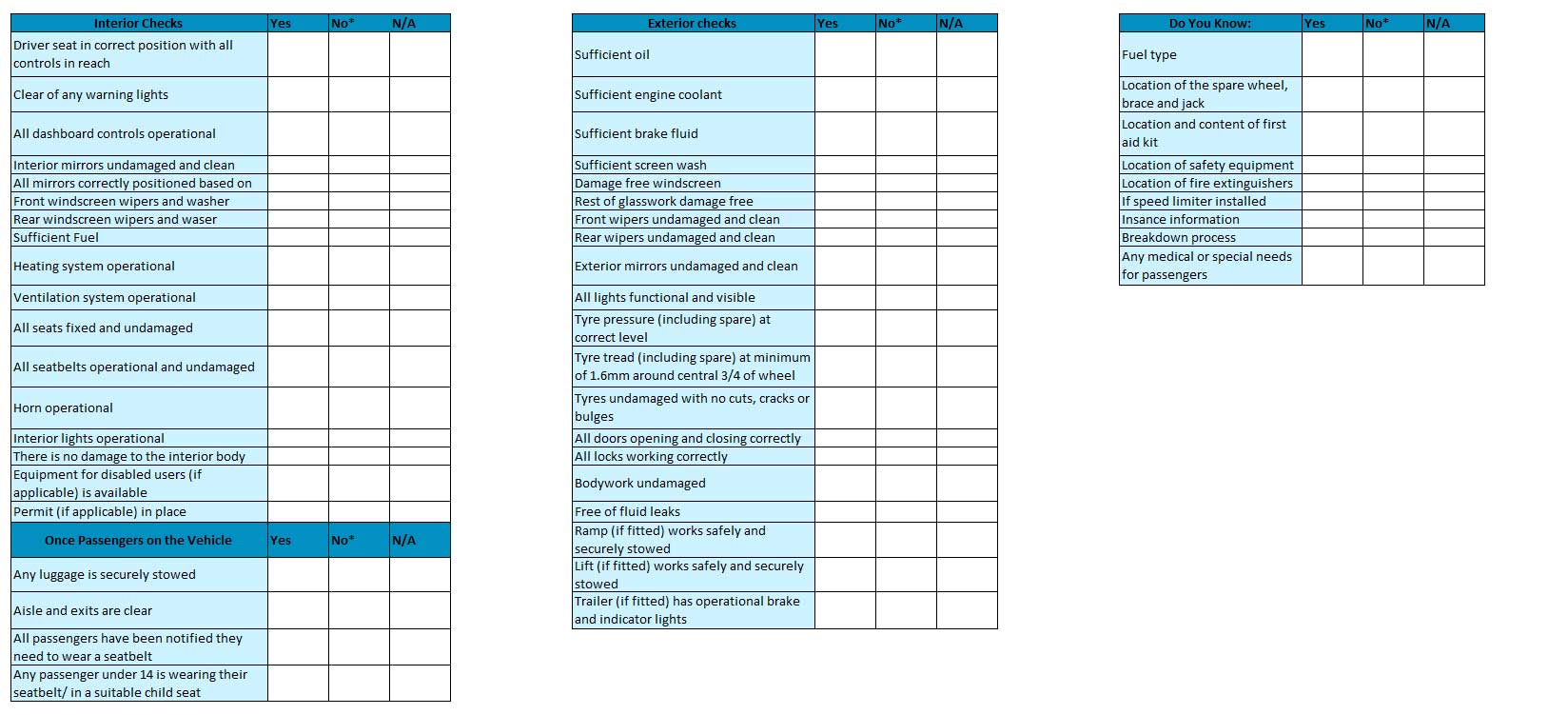

Before you drive a minibus there will be several checks you want to do to make sure that you and your passengers are as safe as possible on the road.
Firstly, before you even agree to drive the vehicle you should:
Once you have agreed to drive a minibus then there are some general practices, we advise you follow for a smooth trip.
Firstly, you should plan your route to make sure you know the distance, and whether you’ll need to refuel, and be able to plan appropriate comfort breaks on longer journeys. When you get into the vehicle you should have this route entered into your sat nav before setting off so you do not need to use a mobile device while the vehicle is moving.
You should also ensure you are fit to drive, this includes being well rested, wearing glasses if needed and are not under the influence of anything including prescription medication if it affects your ability to drive. If you are taking medication and are unsure whether this affects your ability to drive then we recommend speaking to your doctor before you agree to take on driving responsibilities.
We recommend you complete a pre-travel vehicle inspection (we’ve got a detailed example of one below) before you or any passengers get into the vehicle.
It’s also advisable for the driver to have a list of all passengers and any medical conditions or special needs they may have in case the vehicle is involved in an accident. This will help you, and if needed emergency services, take the best possible care of them.
Once you are confident the vehicle is ready for travel then you can let passengers aboard, but make sure the bus is not overloaded with too many passengers or luggage. If there are passengers who use a wheelchair then they are safely restrained if sitting in the chair, or if sitting in a vehicle’s seat that their wheelchair is securely stowed.
If any passengers are carrying an oxygen cylinder, then the appropriate signage must be displayed to advise first responders of its presence in the event of an accident or fire. It will be your responsibility to make sure this sign is displayed.
Before you drive off you should ensure all passengers have been advised they need to wear a seatbelt. If there are any passengers that are under 14 years old you have checked they are wearing theirs as this is your legal responsibility.
As well as checking their seatbelts we recommend you make sure all passengers understand appropriate behaviour before setting off and know not to distract you while the vehicle is moving.
While driving you should stay alert and take regular comfort breaks, especially on longer trips, to keep yourself fed and hydrates, use the facilities and rest where needed. When you do leave the vehicle you should turn the engine off and take the keys with you. If you are travelling with children then we also recommend avoiding leaving them unattended on the vehicle.
Something to be aware of is that minibuses will have different speed limitations to a car and there may be occasions where you should not drive the road’s speed limit. For example, minibuses that are longer than 12 metres cannot exceed 60 mph even on the motorway.
We recommend you leave a larger gap between you and the vehicle ahead then you would when driving your car. A minibus is a longer and heavier vehicle so will have a larger breaking distance if a hazard arises. If you are travelling in poor weather, then you’ll want to increase this distance even more and possibly travel at slower speeds to ensure you have enough reaction time.
If your vehicle is involved in an accident then you should make sure to give clear and concise instructions to your passengers. If there is any risk of fire, no matter how small, you should evacuate the vehicle and get all passengers to a safe distance from the minibus.
Once you arrive at your destination you should try to park so that anyone exiting the vehicle steps onto a footpath not into the road where possible.
Don’t allow anyone to exit the vehicle until you’re at a complete standstill, with the handbrake applied and in a safe location. If you need to operate a lift or ramp for a passenger to disembark then make sure you are able to safely operate this and no other passengers are in the way of doing so.
Once you’ve parked and all passengers have left the vehicle you should inspect the vehicle again to note any damage or issues that may have arisen while travelling.
We mentioned above a vehicle inspection checklist and we would generally recommend that you check for the below:

* If you answered no to any of these please make sure that this does not hinder you from driving the minibus safely and in adherence to your company’s policy and any necessary work is completed as soon as possible.
We also have a downloadable copy of this checklist that you can amend for your needs, print and use here.